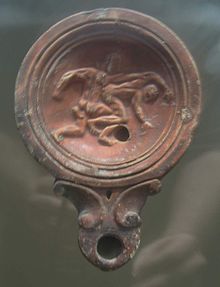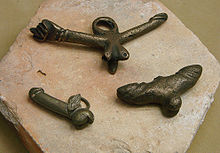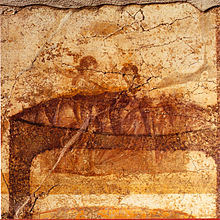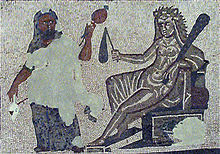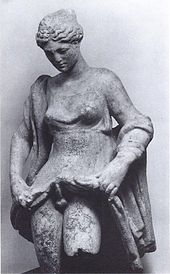- Homosexuality in ancient Rome
-
Same-sex attitudes and behaviors in ancient Rome often differ markedly from those of the contemporary West. Latin lacks words that would precisely translate "homosexual" and "heterosexual." The primary dichotomy of ancient Roman sexuality was active/dominant/masculine and passive/submissive/"feminized". Roman society was patriarchal, and the freeborn male citizen possessed political liberty (libertas) and the right to rule both himself and those of his household (familia). "Virtue" (virtus) was seen as an active quality through which a man (vir) defined himself. The conquest mentality and "cult of virility" shaped same-sex relations. Roman men were free to enjoy sex with other males without a perceived loss of masculinity or social status, as long as they took the dominant or penetrative role. Acceptable male partners were slaves, prostitutes, and entertainers, whose lifestyle placed them in the nebulous social realm of infamia, excluded from the normal protections accorded a citizen even if they were technically free. Although Roman men in general seem to have preferred youths between the ages of 12 and 20 as sexual partners, freeborn male minors were strictly off-limits, and professional prostitutes and entertainers might be considerably older.
Same-sex relations among women are less documented. Although Roman women of the upperclasses were educated, and are known to have written poetry and corresponded with male relatives, very few fragments of anything that might have been written by women survive. Male writers took little interest in how women experienced sexuality in general; the Augustan poet Ovid takes an exceptionally keen interest, but advocates for a heterosexual lifestyle contrary to Roman sexual norms.[1] During the Republic and Principate, little is recorded of sexual relations among women, but better and more varied evidence, though scattered, exists for the later Imperial period.
Contents
Background
During the Republic, a Roman citizen's political liberty (libertas) was defined in part by the right to preserve his body from physical compulsion, including both corporal punishment and sexual abuse.[2] Roman society was patriarchal (see paterfamilias), and masculinity was premised on a capacity for governing oneself and others of lower status.[3] Virtus, "valor" as that which made a man most fully a man, was among the active virtues.[4] The "conquest mentality" was part of a "cult of virility" that particularly shaped Roman homosexual practices.[5] Roman ideals of masculinity were thus premised on taking an active role that was also, as Craig A. Williams has noted, "the prime directive of masculine sexual behavior for Romans."[6] In the late 20th and early 21st centuries, scholars have tended to view expressions of Roman male sexuality in terms of a "penetrator-penetrated" binary model; that is, the proper way for a Roman male to seek sexual gratification was to insert his penis in his partner.[7] Allowing himself to be penetrated threatened his liberty as a free citizen as well as his sexual integrity.[8]
It was expected and socially acceptable for a freeborn Roman man to want sex with both female and male partners, as long as he took the penetrative role.[9] The morality of the behavior depended on the social standing of the partner, not gender per se. Both women and young men were considered normal objects of desire, but outside marriage a man was supposed to act on his desires only with slaves, prostitutes (who were often slaves), and the infames. Gender did not determine whether a sexual partner was acceptable, as long as a man's enjoyment did not encroach on another's man integrity. It was immoral to have sex with another freeborn man's wife, his marriageable daughter, his underage son, or with the man himself; sexual use of another man's slave was subject to the owner's permission. Lack of self-control, including in managing one's sex life, indicated that a man was incapable of governing others; too much indulgence in "low sensual pleasure" threatened to erode the elite male's identity as a cultured person.[10]
In the Imperial era, anxieties about the loss of political liberty and the subordination of the citizen to the emperor were expressed by a perceived increase in voluntary passive homosexual behavior among free men, accompanied by a documentable increase in the execution and corporal punishment of citizens.[11] The dissolution of Republican ideals of physical integrity in relation to libertas contributes to and is reflected by the sexual license and decadence associated with the Empire.[12]
Homoerotic literature and art
Homoerotic themes are introduced to Latin literature during a period of increasing Greek influence on Roman culture in the 2nd century BCE. The consul Quintus Lutatius Catulus was among a circle of poets who made short, light Hellenistic poems fashionable. One of his few surviving fragments is a poem of desire addressed to a male with a Greek name.[13] The elevation of Greek literature and art as models of expression promoted the celebration of homoeroticism as the mark of an urbane and sophisticated person.[14] No assumptions or generalizations should be made about any effect on sexual orientation or real-life behavior among the Romans.[15]
"Greek love" influences aesthetics or the means of expression, not the nature of Roman homosexuality as such. Greek homosexuality differed from Roman primarily in idealizing eros between freeborn male citizens of equal status, though usually with a difference of age (see "Pederasty in ancient Greece"). An attachment to a male outside the family, seen as a positive influence among the Greeks, within Roman society threatened the authority of the paterfamilias.[16] Since Roman women were active in educating their sons and mingled with men socially, and women of the governing classes often continued to advise and influence their sons and husbands in political life, homosociality was not as pervasive in Rome as it had been in Classical Athens, where it is thought to have contributed to the particulars of pederastic culture.[17]
The "new poetry" introduced at the end of the 2nd century came to fruition in the 50s BCE with Gaius Valerius Catullus, whose poems include several expressing desire for a freeborn youth explicitly named "Youth" (Iuventius).[18] The Latin name and freeborn status of the beloved subvert Roman tradition.[19] Catullus's contemporary Lucretius also recognizes the attraction of "boys"[20] (pueri, which can designate an acceptable submissive partner and not specifically age[21]). Homoerotic themes occur throughout the works of poets writing during the reign of Augustus, including elegies by Tibullus[22] and Propertius,[23] the second Eclogue of Vergil, and several poems by Horace. In the Aeneid, Vergil draws on the Greek tradition of homosexuality in a military setting by portraying the love between Nisus and Euryalus,[24] whose military valor marks them as solidly Roman men (viri).[25] Vergil describes their love as pius, linking it to the supreme virtue of pietas as possessed by the hero Aeneas himself, and endorsing it as "honorable, dignified and connected to central Roman values."[26]
By the end of the Augustan period Ovid, Rome's leading literary figure, proposed a radically new heterosexual agenda: making love with a woman is more enjoyable, he says, because unlike the forms of same-sex behavior permissible within Roman culture, the pleasure is mutual.[27] Although Ovid does include mythological treatments of homoeroticism in the Metamorphoses,[28] Thomas Habinek has pointed out that the significance of rupturing human sexuality into categorical preferences has been obscured in the history of sexuality by a later heterosexual bias in Western culture.[29]
In literature of the Imperial period, the Satyricon of Petronius is so permeated with the culture of male-male sexuality that in 18th-century European literary circles, his name became "a byword for homosexuality."[30] The poet Martial often derides women as sexual partners, and celebrates the charms of pueri.
Erotic art and everyday objects
See also: Erotic art in Pompeii and HerculaneumRepresentations of male-male and female-female sexuality are less well-represented in the erotic art of ancient Rome than are male-female sex acts. Roman attitudes toward male nudity differ from those of the ancient Greeks, who regarded idealized portrayals of the nude male as an expression of masculine excellence. The wearing of the toga marked a Roman man as a free citizen.[31] Negative connotations of nudity include defeat in war, since captives were stripped, and slavery, since slaves for sale were often displayed naked.[32] At the same time, the phallus was displayed ubiquitously in the form of the fascinum, a magic charm thought to ward off malevolent forces; it became a customary decoration, found widely in the ruins of Pompeii, especially in the form of wind chimes (tintinnabula).[33] The outsized phallus of the god Priapus may originally have served an apotropaic purpose, but in art it is frequently laughter-provoking or grotesque.[34] Hellenization, however, influenced the depiction of male nudity in Roman art, leading to more complex signification of the male body shown nude, partially nude, or costumed in a muscle cuirass.[35]
Male-male sexuality
Roles
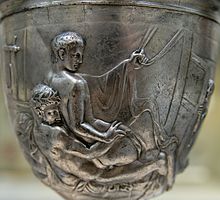 The Warren Cup, portraying a mature bearded man and a youth on its "Greek" side
The Warren Cup, portraying a mature bearded man and a youth on its "Greek" side
A man or boy who took the receiving role in sex was variously called cinaedus, pathicus, exoletus, concubinus (male concubine), spintria ("analist"), puer ("boy"), pullus ("chick"), pusio, delicatus (especially in the phrase puer delicatus, "exquisite" or "dainty boy"), mollis ("soft," used more generally as an aesthetic quality counter to aggressive masculinity), tener ("delicate"), debilis ("weak" or "disabled"), effeminatus, discinctus ("loose-belted"), and morbosus ("sick"). As Amy Richlin has noted, "'gay' is not exact, 'penetrated' is not self-defined, 'passive' misleadingly connotes inaction" in translating this group of words into English.[36]
Some terms, such as exoletus, specifically refer to an adult; Romans who were socially marked as "masculine" did not confine their same-sex penetration of male prostitutes or slaves to those who were "boys" under the age of 20.[37] Some older men may have at times preferred the passive role. Martial describes, for example, the case of an older man who played the passive role and let a younger slave occupy the active role.[38] An adult male's desire to be penetrated was considered a sickness (morbus); the desire to penetrate a handsome youth was thought normal.[39]
Cinaedus
Cinaedus is a derogatory word denoting a male who was gender-deviant; his choice of sex acts, or preference in sexual partner, was secondary to his perceived deficiencies as a "man" (vir).[40] Catullus directs the slur cinaedus at his friend Furius in his notoriously obscene Carmen 16.[41] Although in some contexts cinaedus may denote "passive homosexual"[42] and is the most frequent word for a male who allowed himself to be penetrated anally, [43] it is not equivalent to the English vulgarism "faggot,"[44] and a man called cinaedus might also have sex with and be considered highly attractive to women.[45] His clothing, use of cosmetics, and mannerisms marked him as effeminate,[46] but the same effeminacy that Roman men might find alluring in a puer was unattractive in the physically mature cinaedus.[47] The cinaedus thus represented the absence of what Romans considered true manhood, and the word is virtually untranslatable into English.[48]
Male-male rape
Roman law addressed the rape of a male citizen as early as the 2nd century BC,[49] when a ruling was issued in a case that may have involved a male of same-sex orientation. It was ruled that even a man who was "disreputable and questionable" (famosus, related to infamis, and suspiciosus) had the same right as other free men not to have his body subjected to forced sex.[50] The Lex Julia de vi publica,[51] recorded in the early 3rd century AD but probably dating from the dictatorship of Julius Caesar, defined rape as forced sex against "boy, woman, or anyone"; the rapist was subject to execution, a rare penalty in Roman law.[52] Men who had been raped were exempt from the loss of legal or social standing suffered by those who submitted their bodies to use for the pleasure of others; a male prostitute or entertainer was infamis and excluded from the legal protections extended to citizens in good standing.[53] As a matter of law, a slave could not be raped; he was considered property and not legally a person. The slave's owner, however, could prosecute the rapist for property damage.[54]
Fears of mass rape following a military defeat extended equally to male and female potential victims.[55] According to the jurist Pomponius, "whatever man has been raped by the force of robbers or the enemy in wartime (vi praedonum vel hostium)" ought to bear no stigma.[56]
The threat of one man to subject another to anal or oral rape (irrumatio) is a theme of invective poetry, most notably in Catullus's notorious Carmen 16,[57] and was a form of masculine braggadocio.[58] Rape was one of the traditional punishments inflicted on a male adulterer by the wronged husband,[59] though perhaps more in revenge fantasy than in practice.[60]
In a collection of twelve anecdotes dealing with assaults on chastity, the historian Valerius Maximus features male victims in equal number to female.[61] In a "mock trial" case described by the elder Seneca, an adulescens (a man young enough not to have begun his formal career) was gang-raped by ten of his peers; although the case is hypothetical, Seneca assumes that the law permitted the successful prosecution of the rapists.[62] Another hypothetical case imagines the extremity to which a rape victim might be driven: the freeborn male (ingenuus) who was raped commits suicide.[63] The Romans considered the rape of an ingenuus to be among the worst crimes that could be committed, along with parricide, the rape of a female virgin, and robbing a temple.[64]
Same-sex relations in the military
The Roman soldier, like any free and respectable Roman male of status, was expected to show self-discipline in matters of sex. Augustus (reigned 27 BC–14 AD) even prohibited soldiers from marrying, a ban that remained in force for the Imperial army nearly two centuries, until Septimius Severus rescinded it in 197 AD.[65] Other forms of sexual gratification available to soldiers were prostitutes of any gender, male slaves, war rape, and same-sex relations.[66] The Bellum Hispaniense, about Caesar's civil war on the front in Roman Spain, mentions an officer who has a male concubine (concubinus) on campaign. Sex among fellow soldiers, however, violated the Roman decorum against intercourse with another freeborn male. A soldier maintained his masculinity by not allowing his body to be used for sexual purposes.[67]
In warfare, rape symbolized defeat, a motive for the soldier not to make his body sexually vulnerable in general.[68] During the Republic, homosexual behavior among fellow soldiers was subject to harsh penalties, including death,[69] as a violation of military discipline. Polybius (2nd century BC) reports that the punishment for a soldier who willingly submitted to penetration was the fustuarium, clubbing to death.[70]
Roman historians record cautionary tales of officers who abuse their authority to coerce sex from their soldiers, and then suffer dire consequences.[71] The youngest officers, who still might retain some of the adolescent attraction that Romans favored in male-male relations, were advised to beef up their masculine qualities by not wearing perfume, nor trimming nostril and underarm hair.[72] An incident related by Plutarch in his biography of Marius illustrates the soldier's right to maintain his sexual integrity despite pressure from his superiors. A good-looking young recruit named Trebonius[73] had been sexually harassed over a period of time by his superior officer, who happened to be Marius's nephew, Gaius Luscius. One night, having fended off unwanted advances on numerous occasions, Trebonius was summoned to Luscius's tent. Unable to disobey the command of his superior, he found himself the object of a sexual assault and drew his sword, killing Luscius. A conviction for killing an officer typically resulted in execution. When brought to trial, he was able to produce witnesses to show that he had repeatedly had to fend off Luscius, and "had never prostituted his body to anyone, despite offers of expensive gifts." Marius not only acquitted Trebonius in the killing of his kinsman, but gave him a crown for bravery.[74]
Subculture
Latin had such a wealth of words for men outside the masculine norm that some scholars[75] argue for the existence of a homosexual subculture at Rome; that is, although the noun "homosexual" has no straightforward equivalent in Latin, literary sources reveal a pattern of behaviors among a minority of free men that indicate same-sex preference or orientation. Plautus mentions a street known for male prostitutes.[76] Public baths are also referred to as a place to find sexual partners. Juvenal states that such men scratched their heads with a finger to identify themselves.
Gay marriage
Although Roman law did not recognize marriage between men, in the early Imperial period some male couples were celebrating traditional marriage rites. Same-sex weddings are reported by sources that mock them; the feelings of the participants are not recorded.[77]
Sex acts
In addition to repeatedly described anal intercourse, there is also plenty of evidence that oral sex was common. A graffito from Pompeii is unambiguous: "Secundus is a fellator of rare ability." ("Secundus felator rarus")[78] In contrast to ancient Greece, a large penis was a major element in attractiveness. In Petronius is a description of how a man with such a large penis in a public bathroom looked up, excited.[79] Several emperors are reported in a negative light for surrounding themselves with men with large sexual organs.[80]
Female-female sexuality
See also: History of lesbianism and TribadismReferences to sex between women are infrequent in the Roman literature of the Republic and early Principate. Ovid, who advocates generally for a heterosexual lifestyle, finds it "a desire known to no one, freakish, novel … among all animals no female is seized by desire for female."[81] During the Roman Imperial era, sources for same-sex relations among women are more abundant, in the form of love spells, medical writing, texts on astrology and the interpretation of dreams, and other sources.[82] A graffito from Pompeii expresses the desire of one woman for another:
I wish I could hold to my neck and embrace the little arms, and bear kisses on the tender lips. Go on, doll, and trust your joys to the winds; believe me, light is the nature of men.[83]
Greek words for a woman who prefers sex with another woman include hetairistria (compare hetaira, "courtesan" or "companion"), tribas (plural tribades), and Lesbia; Latin words include the loanword tribas, fricatrix ("she who rubs"), and virago.[84] An early reference to same-sex relations among women as "lesbianism" is found in Lucian (2nd century AD): "They say there are women like that in Lesbos, masculine-looking, but they don't want to give it up for men. Instead, they consort with women, just like men."[85]
Since Romans thought a sex act required an active or dominant partner who was "phallic", male writers imagined that in lesbian sex one of the women would use a dildo or have an exceptionally large clitoris for penetration, and that she would be the one experiencing pleasure.[86] Dildos are rarely mentioned in Roman sources, but were a popular comic item in Classical Greek literature and art.[87] Martial describes lesbians as having outsized sexual appetites and performing penetrative sex on both women and boys.[88] Imperial portrayals of women who sodomize boys, drink and eat like men, and engage in vigorous physical regimens, may reflect cultural anxieties about the growing independence of Roman women.[89]
Gender identity
Transvestism and cross-dressing
Cross-dressing appears in Roman literature and art in various ways to mark the uncertainties and ambiguities of gender:
- as political invective, when a politician is accused of dressing seductively or effeminately;
- as a mythological trope, as in the story of Hercules and Omphale exchanging roles and attire;[90]
- as a form of religious investiture, as for the priesthood of the Galli;
- and rarely or ambiguously as transvestic fetishism.
A section of the Digest by Ulpian[91] categorizes Roman clothing on the basis of who may appropriately wear it: vestimenta virilia, "men's clothing," is defined as the attire of the paterfamilias, "head of household"; puerilia is clothing that serves no purpose other than to mark its wearer as a "child" or minor; muliebria are the garments that characterize a materfamilias; communia, those that are "common," that is, worn by either sex; and familiarica, clothing for the familia, the subordinates in a household, including the staff and slaves. A man who wore women's clothes, Ulpian notes, would risk making himself the object of scorn.
A fragment from the playwright Accius (170–86 BC) seems to refer to a father who secretly wore "virgin's finery."[92] An instance of transvestism is noted in a legal case, in which "a certain senator accustomed to wear women's evening clothes" was disposing of the garments in his will.[93] In the "mock trial" exercise presented by the elder Seneca,[94] the young man (adulescens) was gang-raped while wearing women's clothes in public, but his attire is explained as his acting on a dare by his friends, not as a choice based on gender identity or the pursuit of erotic pleasure.[95]
Gender ambiguity was a characteristic of the priests of the goddess Cybele known as Galli, whose ritual attire included items of women’s clothing. They are sometimes considered a transgendered or transsexual priesthood, since they were required to be castrated in imitation of Attis. The complexities of gender identity in the religion of Cybele and the Attis myth are explored by Catullus in one of his longest poems, Carmen 63.[96]
Hermaphroditism and androgyny
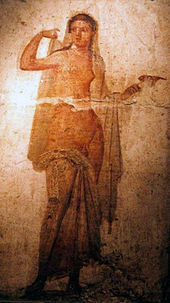 Hermaphroditus in a wall painting from Herculaneum (first half of 1st century AD)
Hermaphroditus in a wall painting from Herculaneum (first half of 1st century AD) Main articles: Hermaphroditus and Aphroditus
Main articles: Hermaphroditus and AphroditusIn contemporary English, "hermaphrodite" is used in biology but has acquired pejorative connotations in referring to people born with physical characteristics of both sexes (see intersex); in antiquity, however, the figure of the so-called hermaphrodite was a primary focus of questions pertaining to gender identity.[97] Pliny notes that "there are even those who are born of both sexes, whom we call hermaphrodites, at one time androgyni" (andr-, "man," and gyn-, "woman," from the Greek).[98] The Sicilian historian Diodorus (latter 1st-century BC) wrote that "there are some who declare that the coming into being of creatures of a kind such as these are marvels (terata), and being born rarely, they announce the future, sometimes for evil and sometimes for good."[99] Isidore of Seville (ca. 560–636) described a hermaphrodite fancifully as those who "have the right breast of a man and the left of a woman, and after coitus in turn can both sire and bear children."[100] Under Roman law, a hermaphrodite had to be classed as either male or female; no third gender existed as a legal category.[101] The hermaphrodite thus represented a "violation of social boundaries, especially those as fundamental to daily life as male and female."[102]
In traditional Roman religion, a hermaphroditic birth was a kind of prodigium, an occurrence that signalled a disturbance of the pax deorum, Rome's treaty with the gods.[103] But Pliny observed that while hermaphrodites were once considered portents, in his day they had become objects of delight (deliciae) who were trafficked in an exclusive slave market.[104]
In the mythological tradition, Hermaphroditus was a beautiful youth who was the son of Hermes (Roman Mercury) and Aphrodite (Venus).[105] Ovid wrote the most influential narrative[106] of how Hermaphroditus became androgynous, emphasizing that although the handsome youth was on the cusp of sexual adulthood, he rejected love as Narcissus had, and likewise at the site of a reflective pool.[107] There the water nymph Salmacis saw and desired him. He spurned her, and she pretended to withdraw until, thinking himself alone, he undressed to bathe in her waters. She then flung herself upon him, and prayed that they might never be parted. The gods granted this request, and thereafter the body of Hermaphroditus contained both male and female. As a result, men who drank from the waters of the spring Salmacis supposedly "grew soft with the vice of impudicitia," according to the lexicographer Festus.[108] The myth of Hylas, the young companion of Hercules who was abducted by water nymphs, shares with Hermaphroditus and Narcissus the theme of the dangers that face the beautiful adolescent male as he transitions to adult masculinity, with varying outcomes for each.[109]
Depictions of Hermaphroditus were very popular among the Romans:
Artistic representations of Hermaphroditus bring to the fore the ambiguities in sexual differences between women and men as well as the ambiguities in all sexual acts. … (A)rtists always treat Hermaphroditus in terms of the viewer finding out his/her actual sexual identity. … Hermaphroditus is a highly sophisticated representation, invading the boundaries between the sexes that seem so clear in classical thought and representation.[110]
Macrobius describes a masculine form of "Venus" (Aphrodite) who received cult on Cyprus; she had a beard and male genitals, but wore women's clothing. The deity's worshippers cross-dressed, men wearing women's clothes, and women men's.[111] The Latin poet Laevius wrote of worshipping "nurturing Venus" whether female or male (sive femina sive mas).[112] The figure was sometimes called Aphroditos. In several surviving examples of Greek and Roman sculpture, the love goddess pulls up her garments to reveal her male genitalia, a gesture that traditionally held apotropaic or magical power.[113]
Under Christian rule
Attitudes toward same-sex behavior changed as Christianity became more pervasive in the Empire. The modern perception of Roman sexual decadence can be traced to early Christian polemic.[114] Apart from measures to protect the liberty of citizens, the prosecution of homosexuality as a general crime began in the 3rd century of the Christian era when male prostitution was banned by Philip the Arab. A series of laws regulating homosexuality were promulgated during the social crisis of the 3rd century, from the statutory rape of minors to gay marriage.[115]
By the end of the 4th century, passive homosexuality under the Christian Empire was punishable by burning.[116] "Death by sword" was the punishment for a "man coupling like a woman" under the Theodosian Code.[117] Under Justinian, all same-sex acts, passive or active, no matter who the partners, were declared contrary to nature and punishable by death.[118] Homosexual behaviors were pointed to as causes for God's wrath following a series of disasters around 542 and 559.[119]
The circumstances surrounding the massacre of Thessalonica in 390 suggest that even in the late 4th century homosexuality was still accepted in large parts of the population, while officially prosecuted.[citation needed] When a popular charioteer was arrested for having sexually harassed an army-commander or servant of the emperor, the people of the town were calling for his release, though this is more likely due to his popularity than to the nature of the allegation.[citation needed]
See also
- Societal attitudes toward homosexuality
- LGBT rights by country or territory
- Lex Scantinia, a poorly document Roman law that protected minors from sexual predators
Notes
- ^ Thomas Habinek, "The Invention of Sexuality in the World-City of Rome," in The Roman Cultural Revolution (Cambridge University Press, 1997), p. 31 et passim.
- ^ Thomas A.J. McGinn, Prostitution, Sexuality and the Law in Ancient Rome (Oxford University Press, 1998), p. 326. See the statement preserved by Aulus Gellius 9.12. 1 that " it was an injustice to bring force to bear against the body of those who are free" (vim in corpus liberum non aecum … adferri).
- ^ Eva Cantarella, Bisexuality in the Ancient World (Yale University Press, 1992, 2002, originally published 1988 in Italian), p. xii.
- ^ Elaine Fantham, "The Ambiguity of Virtus in Lucan's Civil War and Statius' Thebiad," Arachnion 3; Andrew J.E. Bell, "Cicero and the Spectacle of Power," Journal of Roman Studies 87 (1997), p. 9; Edwin S. Ramage, “Aspects of Propaganda in the De bello gallico: Caesar’s Virtues and Attributes,” Athenaeum 91 (2003) 331–372; Myles Anthony McDonnell, Roman manliness: virtus and the Roman Republic (Cambridge University Press, 2006) passim; Rhiannon Evans, Utopia Antiqua: Readings of the Golden Age and Decline at Rome (Routledge, 2008), pp. 156–157.
- ^ Cantarella, Bisexuality in the Ancient World, p. xi; Marilyn B. Skinner, introduction to Roman Sexualities (Princeton University Press, 1997), p. 11.
- ^ Craig A. Williams, Roman Homosexuality (Oxford University Press, 1999), p. 18.
- ^ Rebecca Langlands, Sexual Morality in Ancient Rome (Cambridge University Press, 2006), p. 13.
- ^ For further discussion of how sexual activity defines the free, respectable citizen from the slave or "un-free" person, see Master-slave relations in ancient Rome.
- ^ Amy Richlin, The Garden of Priapus: Sexuality and Aggression in Roman Humor (Oxford University Press, 1983, 1992), p. 225.
- ^ Catharine Edwards, "Unspeakable Professions: Public Performance and Prostitution in Ancient Rome," in Roman Sexualities, pp. 67–68.
- ^ Amy Richlin, "Sexuality in the Roman Empire," in A Companion to the Roman Empire (Blackwell, 2006), p. 329. The law began to specify harsher punishments for the lower classes (humiliores) than for the elite (honestiores).
- ^ This is a theme throughout Carlin A. Barton, The Sorrows of the Ancient Romans: The Gladiator and the Monster (Princeton University Press, 1993).
- ^ Cantarella, Bisexuality in the Ancient World, p. 120; Edward Courtney, The Fragmentary Latin Poets (Oxford: Clarendon Press, 1992), p. 75.
- ^ Ramsay MacMullen, "Roman Attitudes to Greek Love," Historia 31.4 (1982), pp. 484–502.
- ^ David M. Halperin, "The First Homosexuality?" in The Sleep of Reason: Erotic Experience and Sexual Ethics in Ancient Greece (University of Chicago Press, 2002), pp. 242 and 263, with criticism of MacMullen.
- ^ Cantarella, Bisexuality in the Ancient World, p. xi; Skinner, introduction to Roman Sexualities, p. 11.
- ^ Cantarella, Bisexuality in the Ancient World, pp. xi–xii; Skinner, introduction to Roman Sexualities, pp. 11–12.
- ^ Catullus, Carmina 24, 48, 81, 99.
- ^ John Pollini, "The Warren Cup: Homoerotic Love and Symposial Rhetoric in Silver," Art Bulletin 81.1 (1999), p. 28.
- ^ Lucretius, De rerum natura 4.1052–1056). See also Sexuality in ancient Rome#Epicurean sexuality.
- ^ Richlin, "Not before Homosexuality," p. 536.
- ^ Tibullus, Book One, elegies 4, 8, and 9.
- ^ Propertius 4.2.
- ^ Williams, Roman Homosexuality, pp. 116–119.
- ^ Mark Petrini, The Child and the Hero: Coming of Age in Catullus and Vergil (University of Michigan Press, 1997), pp. 24–25.
- ^ James Anderson Winn, The Poetry of War (Cambridge University Press, 2008), p. 162.
- ^ Ovid, Ars Amatoria 2.683–684; Pollini, "Warren Cup," p. 36.
- ^ As at Metamorphoses 10.155ff.
- ^ Habinek, "The Invention of Sexuality in the World-City of Rome," p. 31 et passim.
- ^ Louis Crompton, Byron and Greek Love (London, 1998), p. 93.
- ^ Habinek, "The Invention of Sexuality in the World-City of Rome," in The Roman Cultural Revolution, p. 39.
- ^ Williams, Roman Homosexuality, pp. 69–70.
- ^ Amy Richlin, "Pliny's Brassiere," in Roman Sexualities, p. 215.
- ^ David Fredrick, The Roman Gaze: Vision, Power, and the Body (Johns Hopkins University Press, 2002), p. 156.
- ^ Paul Zanker, The Power of Images in the Age of Augustus (University of Michigan Press, 1988), pp. 239–240, 249–250 et passim.
- ^ Amy Richlin, "Not before Homosexuality: The Materiality of the cinaedus and the Roman Law against Love between Men," Journal of the History of Sexuality 3.4 (1993), p. 531.
- ^ Williams, Roman Homosexuality, p. 85 et passim.
- ^ Martial, 3.71.
- ^ Williams, Roman Homosexuality, p. 200.
- ^ Williams, Roman Homosexuality, p. 197.
- ^ Williams, Roman Homosexuality, p. 181ff. and 193.
- ^ Williams, Roman Homosexuality, p. 197.
- ^ Williams, Roman Homosexuality, p. 193.
- ^ Williams, Roman Homosexuality, p. 6.
- ^ Williams, Roman Homosexuality, p. 197.
- ^ Williams, Roman Homosexuality, p. 197.
- ^ Williams, Roman Homosexuality, pp. 203–204.
- ^ Williams, Roman Homosexuality, pp. 55, 202.
- ^ Richlin, "Not before Homosexuality," p. 561.
- ^ As recorded in a fragment of the speech De Re Floria by Cato the Elder (frg. 57 Jordan = Aulus Gellius 9.12.7), as noted and discussed by Richlin, "Not before Homosexuality," p. 561.
- ^ Digest 48.6.3.4 and 48.6.5.2.
- ^ Richlin, "Not before Homosexuality," pp. 562–563. See also Digest 48.5.35 [34] on legal definitions of rape that included boys.
- ^ Richlin, "Not before Homosexuality," pp. 558–561.
- ^ Cantarella, Bisexuality in the Ancient World, pp. 99, 103; McGinn, Prostitution, Sexuality and the Law, p. 314.
- ^ Williams, Roman Homosexuality, pp. 104–105.
- ^ Digest 3.1.1.6, as noted by Richlin, "Not before Homosexuality," p. 559.
- ^ Richlin, The Garden of Priapus, pp. 27–28, 43 (on Martial), 58, et passim.
- ^ Williams, Roman Homosexuality, p. 20; Skinner, introduction to Roman Sexualities, p. 12; Amy Richlin, "The Meaning of irrumare in Catullus and Martial," Classical Philology 76.1 (1981) 40–46.
- ^ Williams, Roman Homosexuality, pp. 27, 76 (with an example from Martial 2.60.2.
- ^ Catharine Edwards, The Politics of Immorality in Ancient Rome (Cambridge University Press, 1993), pp. 55–56.
- ^ Valerius Maximus 6.1; Richlin, "Not before Homosexuality," p. 564.
- ^ Richlin, "Not before Homosexuality," p. 564.
- ^ Quintilian, Institutio oratoria 4.2.69–71; Richlin, "Not before Homosexuality," p. 565.
- ^ Richlin, "Not before Homosexuality," p. 565, citing the same passage by Quintilian.
- ^ Men of the governing classes, who would have been officers above the rank of centurion, were exempt. Pat Southern, The Roman Army: A Social and Institutional History (Oxford University Press, 2006), p. 144; Sara Elise Phang, The Marriage of Roman Soldiers (13 B.C.–A.D. 235): Law and Family in the Imperial Army (Brill, 2001), p. 2.
- ^ Phang, The Marriage of Roman Soldiers, p. 3.
- ^ Sara Elise Phang, Roman Military Service: Ideologies of Discipline in the Late Republic and Early Principate (Cambridge University Press, 2008), p. 93.
- ^ Phang, Roman Military Service, p. 94. See section above on male rape: Roman law recognized that a soldier might be raped by the enemy, and specified that a man raped in war should not suffer the loss of social standing that an infamis did when willingly undergoing penetration; Digest 3.1.1.6, as discussed by Richlin, "Not before Homosexuality," p. 559.
- ^ Thomas A.J. McGinn, Prostitution, Sexuality and the Law in Ancient Rome (Oxford University Press, 1998), p. 40.
- ^ Polybius, Histories 6.37.9 (translated as bastinado).
- ^ Phang, The Marriage of Roman Soldiers, pp. 280–282.
- ^ Phang, Roman Military Service, p. 97, citing among other examples Juvenal, Satire 14.194–195.
- ^ The name is given elsewhere as Plotius.
- ^ Plutarch, Life of Marius 14.4–8; see also Valerius Maximus 6.1.12; Cicero, Pro Milone 9, in Dillon and Garland, Ancient Rome, p. 380; and Dionysius of Halicarnassus 16.4. Discussion by Phang, Roman Military Service, pp. 93–94, and The Marriage of Roman Soldiers, p. 281; Cantarella, Bisexuality in the Ancient World, pp. 105–106.
- ^ Primarily Amy Richlin, as in "Not before Homosexuality."
- ^ Plautus, Curculio 482-84
- ^ Both Juvenal (for instance, in Satire 2) and Martial describe weddings between men. Suetonius reports that the emperor Nero had two marriages to men, once taking the role of the bride, and once the groom. See Williams, Roman Homosexuality, p. 28; Karen K. Hersh, The Roman Wedding: Ritual and Meaning in Antiquity (Cambridge University Press, 2010), p. 36; Caroline Vout, Power and Eroticism in Imperial Rome (Cambridge University Press, 2007), pp. 151ff.
- ^ CIL 4, 9027; translation from Hubbard, Homosexuality, 423
- ^ Petronius: Satyricon
- ^ Aelius Lampridius: Scripta Historia Augusta, Commodus, 10.9
- ^ Ovid, Metamorphoses 9.727, 733–4, as cited by Richlin, "Sexuality in the Roman Empire," p. 346.
- ^ Bernadette J. Brooten, Love between Women: Early Christian Responses to Female Homoeroticism (University of Chicago Press, 1996), p. 1.
- ^ The Latin indicates that the I is of feminine gender; CIL 4.5296, as cited by Richlin, "Sexuality in the Roman Empire," p. 347.
- ^ Brooten, Love between Women, p. 4.
- ^ Lucian, Dialogues of the Courtesans 5.
- ^ Jonathan Walters, "Invading the Roman Body: Manliness and Impenetrability in Roman Thought," pp. 30–31, and Pamela Gordon, "The Lover's Voice in Heroides 15: Or, Why Is Sappho a Man?," p. 283, both in Roman Sexualities; John R. Clarke, "Look Who's Laughing at Sex: Men and Women Viewers in the Apodyterium of the Suburban Baths at Pompeii," both in The Roman Gaze, p. 168.
- ^ Richlin, "Sexuality in the Roman Empire," p. 351.
- ^ Martial 1.90 and 7.67, 50; Richlin, "Sexuality in the Roman Empire," p. 347; John R. Clarke, Looking at Lovemaking: Constructions of Sexuality in Roman Art 100 B.C.–A.D. 250 (University of California Press, 1998, 2001), p. 228.
- ^ Clarke, Looking at Lovemaking, p. 228.
- ^ Ovid adduces the story of Hercules and Omphale as an explanation for the ritual nudity of the Lupercalia; see "Male nudity in ancient Rome" and Richard J. King, Desiring Rome: Male Subjectivity and Reading Ovid's Fasti (Ohio State University Press, 2006), pp. 185, 195, 200, 204.
- ^ Digest 34.2.23.2, as cited by Richlin, "Not before Homosexuality," p. 540.
- ^ Cum virginali mundo clam pater: Kelly Olson, "The Appearance of the Young Roman Girl," in Roman Dress and the Fabrics of Roman Culture (University of Toronto Press, 2008), p. 147.
- ^ Digest 34.2.33, as cited by Richlin, "Not before Homosexuality," p. 540.
- ^ See above under "Male-male rape."
- ^ Seneca the Elder, Controversia 5.6; Richlin, "Not before Homosexuality," p. 564.
- ^ Stephen O. Murray, Homosexualities (University of Chicago Press, 2000), pp. 298–303; Mary R. Bachvarova, "Sumerian Gala Priests and Eastern Mediterranean Returning Gods: Tragic Lamentation in Cross-Cultural Perspective," in Lament: Studies in the Ancient Mediterranean and Beyond (Oxford University Press, 2008), pp. 19, 33, 36.
- ^ Clarke, Looking at Lovemaking, p. 49; Rabun Taylor, The Moral Mirror of Roman Art (Cambridge University Press, 2008), p. 78.
- ^ Pliny, Natural History 7.34: gignuntur et utriusque sexus quos hermaphroditos vocamus, olim androgynos vocatos; Veronique Dasen, "Multiple Births in Graeco-Roman Antiquity," Oxford Journal of Archaeology 16.1 (1997), p. 61.
- ^ Diodorus Siculus 4.6.5; Will Roscoe, "Priests of the Goddess: Gender Transgression in Ancient Religion," in History of Religions 35.3 (1996), p. 204.
- ^ Isidore of Seville, Eytmologiae 11.3. 11.
- ^ Lynn E. Roller, "The Ideology of the Eunuch Priest," Gender & History 9.3 (1997), p. 558.
- ^ Roscoe, "Priests of the Goddess," p. 204.
- ^ Veit Rosenberger, "Republican nobiles: Controlling the Res Publica," in A Companion to Roman Religion (Blackwell, 2007), p. 295.
- ^ Plutarch, Moralia 520c; Dasen, "Multiple Births in Graeco-Roman Antiquity," p. 61.
- ^ Ovid, Metamorphoses 4.287–88.
- ^ Taylor, The Moral Mirror of Roman Art, p. 77; Clarke, Looking at Lovemaking, p. 49.
- ^ Taylor, The Moral Mirror of Roman Art, p. 78ff.
- ^ Paulus ex Festo 439L; Richlin, "Not before Homosexuality," p. 549.
- ^ Taylor, The Moral Mirror of Roman Art, p. 216, note 46.
- ^ Clarke, Looking at Lovemaking, pp. 54–55.
- ^ Macrobius, Saturnalia 3.8.2. Macrobius says that Aristophanes called this figure Aphroditos.
- ^ Venerem igitur almum adorans, sive femina sive mas est, as quoted by Macrobius, Saturnalia 3.8.3.
- ^ Dominic Montserrat, "Reading Gender in the Roman World," in Experiencing Rome: Culture, Identity, and Power in the Roman Empire (Routledge, 2000), pp. 172–173.
- ^ Alastair J.L. Blanshard, "Roman Vice," in Sex: Vice and Love from Antiquity to Modernity (Wiley-Blackwell, 2010), pp. 1–88.
- ^ John Boswell, Christianity, Social Tolerance, and Homosexuality: Gay People in Western Europe from the Beginning of the Christian Era to the Fourteenth Century (University of Chicago Press, 1980), p. 70.
- ^ Michael Groneberg, "Reasons for Homophobia: Three Types of Explanation," in Combatting Homophobia: Experiences and Analyses Pertinent to Education (LIT Verlag, 2011), p. 193.
- ^ Codex Theodosianus 9.7.3 (4 December 342), introduced by the sons of Constantine in 342.
- ^ Groneberg, "Reasons for Homophobia," p. 193.
- ^ Michael Brinkschröde, "Christian Homophobia: Four Central Discourses," in Combatting Homophobia, p. 166.
Literature
- Boswell, John: Christianity, Social Tolerance and Homosexuality (University of Chicago) 1980, "Rome: The Foundation", pp 61-87
- Thomas K. Hubbard: Homosexuality in Greece and Rome, a Sourcebook of Basic Documents. Los Angeles, London 2003. ISBN 0-520-23430-8
- Craig Williams: Roman Homosexuality, Ideologies of Masculinity in Classical Antiquity. in: Oxford University Press (Editor): Ideologies of Desire. Oxford 1999
- William Percy: The Age of Marriage in Ancient Rome, Lewiston, New York: The Edwin Mellen Press, 2003 (together with Arnold Lelis and Beert Verstraete)
See also
Lesbian, gay, bisexual, transgender history Timeline of LGBT history • Homosexuality in ancient Egypt • Homosexuality in ancient Greece • Homosexuality in ancient Rome (Hadrian and Antinous) • Lex Scantinia • Greek love • Homosexuality in ancient Peru • Pink Triangle • Stonewall riots • UK Gay Liberation Front 1971 Festival of Light action • LGBT history in Singapore • Lesbian American history • History of Christianity and homosexuality • History of lesbianism • Timeline of same-sex marriage • History of same-sex unions • LGBT History MonthCategories:- Sexuality in ancient Rome
- LGBT history in Italy
- LGBT history prior to the 19th century
- Male homosexuality
Wikimedia Foundation. 2010.

